Graphics Reference
In-Depth Information
1000
010 0
000
1
6
0001
Ê
ˆ
10 0 0
01 0 0
00 1 0
00 61
1000
0100
0010
0061
Ê
ˆ
Ê
ˆ
Á
Á
Á
Á
˜
˜
˜
˜
Á
Á
Á
˜
˜
˜
Á
Á
Á
˜
˜
˜
-
1
R
´
R
´
C
´
16
Ë
¯
Ë
¯
-
Ë
¯
Multiplying these matrices together (in the opposite order from the maps) we get that
S has matrix
100
1
3
010
1
6
001
1
6
000 0
Ê
ˆ
Á
Á
Á
Á
Á
Á
˜
˜
˜
˜
˜
˜
-
.
(3.31)
Ë
¯
This means that the homogeneous equations for S are
¢xx
¢yy
¢zz
1
3
1
6
1
6
wx
¢=
-
y
+
z
Dividing through by w¢ leads to the same nonhomogeneous equations for S as before.
Note that these equations give the right results for the points
A
,
B
, and
C
.
A third solution to the problem uses strictly rigid motions and frames. (The trans-
formation T above is not a rigid motion.) Our first goal is to find an orthonormal basis
u
1
,
u
2
, and
u
3
for 3-space so that the first two vectors are an orthonormal basis for
X
. To find
u
1
and
u
2
we use the Gram-Schmidt algorithm on any basis of
X
. Using
the basis
AB
and
AC
leads to
1
5
1
30
(
)
(
)
u
=
120
,,
and
u
=
-
215
,, .
1
2
Since the equation for
X
implies that (2,-1,1) is a normal vector for
X
we can let
1
6
(
)
u
3
=
211
,,.
-
Let F be the frame (
u
1
,
u
2
,
u
3
). Then F
-1
transforms a point (x,y,z) into F-coordinates
(x¢,y¢,z¢). In this coordinate system the plane
X
becomes the plane
X
¢ defined by
the equation z¢=
6
. (
X
was a distance
6
from the origin.) In other words, if R is
the translation with translation vector (0,0,-
6
), then






